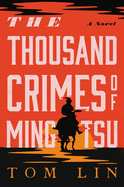
Warning: the number of corpses could actually exceed the page count in Tom Lin's addictively gruesome debut, The Thousand Crimes of Ming Tsu. Set between the Utah Territories and California in the late 1800s, Lin's novel manages to enhance a wild, wild western with Odyssean devotion, magic realism and historical racism, to create quite the unlikely love story gone awry.
Orphan Ming Tsu doesn't remember his immigrant Chinese parents; he was raised instead by a "caretaker" who "treated [him] like a son" but also trained him to be an efficient killer. Ming carries a notebook in which six scribbled names will determine his destiny: a labor recruiter, a gang boss, a sheriff, a judge, two brothers, each of whom helped shatter his life 10 years ago by stealing his wife, Ada, and damning him to railroad chain gang labor. Accompanied by a blind, death-foretelling Chinese "prophet," Ming will methodically wreak revenge.
For all his life, Lin's protagonist has seemingly discarded his Chinese roots--raised by a white man, unable to speak Chinese, repeatedly disowning his "countrymen"--and yet Ming cannot escape his Asian skin, the denigrating labels, his erasure with the lazy moniker "John." His Chinese ancestry cost him his white wife: anti-miscegenation laws gave Ada's father the power to destroy his marriage and sentence him to dehumanizing labor. With dexterous agility, Lin showcases Ming's multi-faceted identity as a native-born American, a builder of transcontinental railroads, a rebel against racist laws, a killer of injustice--and maybe even a hero who might finally get the girl. --Terry Hong, Smithsonian BookDragon

